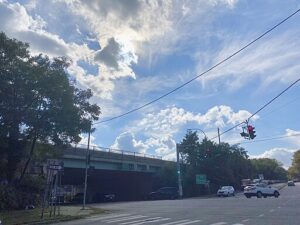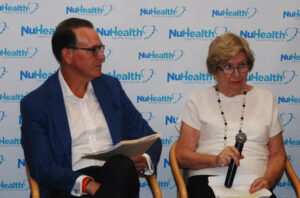By Madeline Armstrong
The toxic Lake Agawam in Southampton is showing possible signs of eventual restoration to health, according to Christopher Gobler, professor of marine and atmospheric sciences at Stony Brook University.
As reported in The Long Island Advocate in May 2021, new ultrasonic technology was combined with the use of hydrogen peroxide to eradicate harmful algal blooms that have ravaged the lake.
“It eliminated the toxic algae in the short term in Lake Agawam,” Southampton Mayor Jesse Warren said.
Gobler reported that there was no change noted from the ultrasonic devices. The hydrogen peroxide, though, was effective in eliminating algal blooms. The first treatment lasted for a few weeks, but the second treatment, administered in July, lasted a day.
According to Gobler, the treatments were short term, “addressing the symptom, but not the root cause. The root cause… is the overloading of nitrogen and the overloading of phosphorus into the lake. Those nutrients are coming from wastewater and the sediments at the bottom of the lake.”
A number of programs are being implemented to address the issue over the long term. Southampton has received several grants to fund potential solutions, including nearly $987,000 in New York State funding to install bioswales on Main Street in Southampton. Bioswales are garden-filled channels full of native plants alongside the road that catch rain and prevent runoff of nitrogen-loaded fertilizer into local waterways.
There will also be a bioswale installed on Nugent Road, funded by the Suffolk County Water Quality Protection and Restoration Program and the Town of Southampton Community Preservation Fund.
“Bioswales cleanse not only our lake and pond waters, but the water we drink, bathe and swim in,” said Meghan Magyar, director of the Lake Agawam Conservancy. “Lake Agawam Conservancy has installed three significant bioswales around the lake in the past two years.”
Southampton also received a $134,250 CFP grant to continue studying the potential benefits of installing a permeable reactive barrier at the north end of the lake. According to Gobler, the barrier is placed in the ground; it then intercepts contaminated groundwater as it flows into the lake and removes nitrogen.
According to Warren, a stormwater runoff project was recently completed on Gin Lane. “[This is] helpful in preventing stormwater runoff from getting into the lake and obviously some of those nutrients that also get into the lake,” Warren said.
Additionally, the village is looking to install an algae skimmer. According to Gobler, this would reduce the number of blue-green algae blooms. “Intercepting the growth of the harmful cyanobacteria will help alleviate the outbreaks,” he said.
“Even if we prevent all the stormwater from getting into the lake, even if we remove all the algae and prevent additional nutrients from getting into the lake, nitrogen and phosphorus are still in the groundwater.”
Southampton Mayor Jesse Warren
Warren stressed that the crux of the problem lies in the sewers. “The sewer’s really going to be one of the more important pieces of the puzzle because, even if we prevent all the stormwater from getting into the lake, even if we remove all the algae and prevent additional nutrients from getting into the lake, nitrogen and phosphorus are still in the groundwater,” Warren said. “There is a 20-year legacy load of groundwater that will continue to get into the lake, even if we solve every single problem.”
According to Gobler, a sewage treatment plant will be built in the village that will take wastewater from Main Street and send it to a plant where the water will be treated before it discharges into the lake.
Additionally, Janice Scherer, the Lake Agawam Conservancy’s science adviser, urged residents to take advantage of the grants available to replace their old septic systems with new low-nitrogen ones. “There are grants available for up to $40,000 per home,” Scherer said.
Also, she said not to use toxic chemicals, including synthetic fertilizer, in your landscape; if you live around a lake or a pond, plant a buffer of native plants to help prevent runoff. A Suffolk County law also passed requiring any building under construction to switch to or install a low-nitrogen septic system, according to Warren.
Although the lake looks better than it did in previous years, there is still much work to be done. “There’s no silver magic bullet,” said Adrienne Esposito, executive director of the Farmingdale-based Citizens Campaign for the Environment. “It’s going to be a combination of addressing all of the sources of nitrogen and phosphorus heading into that lake.”
Gobler said he believes things are headed in the right direction. He also plans to undertake more experiments this year to see what can be done to break down the sediments. He also hopes to dredge the bottom of the lake, which could be a long and expensive process.
“Lake Agawam is not unique; it is a symbol of the pollution that plagues the water on Long Island,” Magyar said. “All of our water will become toxic if we do not take two simple steps: upgrade our septic systems to low-nitrogen systems and stop using poisonous lawn chemicals.”









